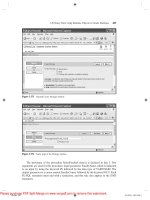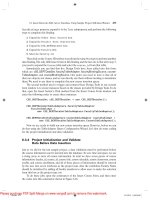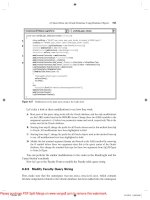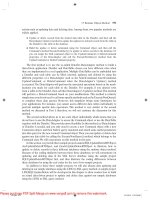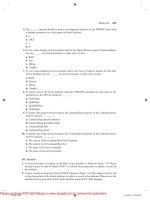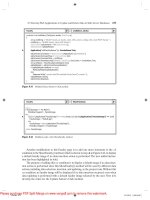BEGINNING C sharp 7 programming with visual studio 2017
Bạn đang xem bản rút gọn của tài liệu. Xem và tải ngay bản đầy đủ của tài liệu tại đây (21.93 MB, 913 trang )
BEGINNING
C# 7 Programming
with Visual Studio® 2017
Benjamin Perkins
Jacob Vibe Hammer
Jon D. Reid
Beginning C# 7 Programming with Visual Studio® 2017
Published by
John Wiley & Sons, Inc.
10475 Crosspoint Boulevard
Indianapolis, IN 46256
www.wiley.com
Copyright © 2018 by John Wiley & Sons, Inc., Indianapolis, Indiana
Published simultaneously in Canada
ISBN: 978-1-119-45868-5
ISBN: 978-1-119-45872-2 (ebk)
ISBN: 978-1-119-45866-1 (ebk)
Manufactured in the United States of America
10 9 8 7 6 5 4 3 2 1
No part of this publication may be reproduced, stored in a retrieval system or transmitted in any form or by any means,
electronic, mechanical, photocopying, recording, scanning or otherwise, except as permitted under Sections 107 or 108
of the 1976 United States Copyright Act, without either the prior written permission of the Publisher, or authorization
through payment of the appropriate per-copy fee to the Copyright Clearance Center, 222 Rosewood Drive, Danvers,
MA 01923, (978) 750-8400, fax (978) 646-8600. Requests to the Publisher for permission should be addressed to the
Permissions Department, John Wiley & Sons, Inc., 111 River Street, Hoboken, NJ 07030, (201) 748-6011, fax (201)
748-6008, or online at />Limit of Liability/Disclaimer of Warranty: The publisher and the author make no representations or warranties with
respect to the accuracy or completeness of the contents of this work and specifically disclaim all warranties, including
without limitation warranties of fitness for a particular purpose. No warranty may be created or extended by sales or promotional materials. The advice and strategies contained herein may not be suitable for every situation. This work is sold
with the understanding that the publisher is not engaged in rendering legal, accounting, or other professional services.
If professional assistance is required, the services of a competent professional person should be sought. Neither the publisher nor the author shall be liable for damages arising herefrom. The fact that an organization or Web site is referred to
in this work as a citation and/or a potential source of further information does not mean that the author or the publisher
endorses the information the organization or Web site may provide or recommendations it may make. Further, readers
should be aware that Internet Web sites listed in this work may have changed or disappeared between when this work was
written and when it is read.
For general information on our other products and services please contact our Customer Care Department within the
United States at (877) 762-2974, outside the United States at (317) 572-3993 or fax (317) 572-4002.
Wiley publishes in a variety of print and electronic formats and by print-on-demand. Some material included with standard print versions of this book may not be included in e-books or in print-on-demand. If this book refers to media such
as a CD or DVD that is not included in the version you purchased, you may download this material at http://
booksupport.wiley.com. For more information about Wiley products, visit www.wiley.com.
Library of Congress Control Number: 2018933383
Trademarks: Wiley, the Wiley logo, Wrox, the Wrox logo, Programmer to Programmer, and related trade dress are trademarks or registered trademarks of John Wiley & Sons, Inc. and/or its affiliates, in the United States and other countries,
and may not be used without written permission. Visual Studio is a registered trademark of Microsoft Corporation. All
other trademarks are the property of their respective owners. John Wiley & Sons, Inc., is not associated with any product
or vendor mentioned in this book.
ABOUT THE AUTHORS
BENJAMIN PERKINS (MBA, MCSD, ITIL) is currently employed at Microsoft in Munich, Germany,
as a Senior Escalation Engineer. He has been working professionally in the IT industry for over two
decades. He started computer programming with QBasic at the age of 11 on an Atari 1200XL desktop computer. He takes pleasure in the challenges that troubleshooting technical issues has to offer
and savors the rewards of a well-written program. After completing high school he joined the United
States Army. After successfully completing his military service, he attended Texas A&M University
in College Station, Texas, where he received a Bachelor of Business Administration in Management
Information Systems.
His roles in the IT industry have spanned the entire spectrum including programmer, system
architect, technical support engineer, team leader, and mid-level management. While employed at
Hewlett-Packard, he received numerous awards, degrees, and certifications. He has a passion for
technology and customer service and looks forward to troubleshooting and writing more worldclass technical solutions.
“My approach is to write code with support in mind, and to write it once correctly and completely
so we do not have to come back to it again, except to enhance it.”
Benjamin is married to Andrea and has two wonderful children, Lea and Noa.
JACOB VIBE HAMMER helps develop solutions for the health care industry as a Senior Software
Engineer at Systematic in Denmark. He started programming just about the time when he was able
to spell the word “BASIC”—which, incidentally, is the first programming language he ever used.
Since then, he has worked with numerous programming languages and solution architectures;
however, since the turn of the century, he has worked primarily with the .NET platform. Today,
his programming time is spent working primarily with C# and WPF, as well as toying with NoSQL
databases. A Danish citizen, Jacob lives in Aarhus, Denmark, with his wife and two sons.
JON D. REID is a Product Solution Manager for IFS Field Service Management (www.IFSWORLD
.com). He has coauthored a number of books, including Beginning Visual C# 2015, Fast Track C#,
Pro Visual Studio .NET, and many others.
ABOUT THE TECHNICAL EDITOR
JOHN MUELLER is a freelance author and technical editor. He has writing in his blood, having pro-
duced 108 books and more than 600 articles to date. The topics range from networking to artificial
intelligence and from database management to heads-down programming. Some of his current
books include topics such as Python for beginners, Python for data scientists, and Amazon Web
Services. He has also written about algorithms and machine learning. His technical editing skills
have helped more than 70 authors refine the content of their manuscripts. John has provided
technical editing services to a number of computing magazines. Be sure to read John’s blog at
/>
CREDITS
SENIOR ACQUISITIONS EDITOR
Kenyon Brown
PROJECT EDITOR
Tom Dinse
TECHNICAL EDITOR
John Mueller
PRODUCTION EDITOR
Barath Kumar Rajasekaran
COPY EDITOR
First Edition Publishing Services
PRODUCTION MANAGER
Katie Wisor
MANAGER OF CONTENT ENABLEMENT
AND OPERATIONS
Pete Gaughan
MARKETING MANAGER
Christie Hilbrich
BUSINESS MANAGER
Amy Knies
PROJECT COORDINATOR, COVER
Brent Savage
PROOFREADER
Nancy Bell
INDEXER
Johnna VanHoose Dinse
COVER DESIGNER
Wiley
COVER IMAGE
©Ben Clift Williams/EyeEm/Getty Images
ACKNOWLEDGMENTS
It takes a lot of work to get content into a presentable format for students and IT professionals to
read and get value from. The authors indeed have technical knowledge and experiences to share, but
without the technical writers, technical reviewers, developers, editors, publishers, graphic designers,
the list goes on, providing their valuable input, a book of high quality could not be written. The rate
of change occurs too quickly for an individual to perform all these tasks and still publish a book
that is valid before the technology becomes stale. This is why authors worked together with a great
team to get all the components of the book together quickly. It was done to ensure that the most up
to date information gets to the reader while the features are still fresh and current. I would like to
thank Tom Dinse for his great project management and technical review of the content as well as
John Mueller for his technical review and suggestions throughout the process. Lastly, I would like to
thank all the numerous people behind the scenes who helped get this book together.
CONTENTS
INTRODUCTION
xxi
Part I: THE C# LANGUAGE
Chapter 1: INTRODUCING C#
3
What Is the .NET Framework?
4
What’s in the .NET Framework?
4
.NET Standard and .NET Core
5
Writing Applications Using the .NET Framework and .NET Core
5
CIL and JIT
6
Assemblies7
Managed Code
7
Garbage Collection
7
Fitting It Together
8
Linking9
What Is C#?
Applications You Can Write with C#
C# in this Book
Visual Studio 2017
9
10
11
11
Visual Studio 2017 Products
11
Solutions12
Chapter 2: WRITING A C# PROGRAM
The Visual Studio 2017 Development Environment
Console Applications
The Solution Explorer
The Properties Window
The Error List Window
Desktop Applications
Chapter 3: VARIABLES AND EXPRESSIONS
15
16
21
24
25
25
26
33
Basic C# Syntax
34
Basic C# Console Application Structure
36
Variables38
Simple Types
38
CONTENTS
Variable Naming
Literal Values
Binary Literals and Digit Separators
String Literals
43
43
44
45
Expressions46
Mathematical Operators
47
Assignment Operators
52
Operator Precedence
53
Namespaces54
Chapter 4: FLOW CONTROL
Boolean Logic
Boolean Bitwise and Assignment Operators
Operator Precedence Updated
59
60
62
64
Branching65
The Ternary Operator
The if Statement
Checking More Conditions Using if Statements
The switch Statement
65
65
68
69
Looping72
do Loops
while Loops
for Loops
Interrupting Loops
Infinite Loops
Chapter 5: MORE ABOUT VARIABLES
Type Conversion
Implicit Conversions
Explicit Conversions
Explicit Conversions Using the Convert Commands
Complex Variable Types
73
75
77
78
79
83
84
84
86
88
91
Enumerations91
Defining Enumerations
92
Structs96
Defining Structs
96
Arrays99
Declaring Arrays
99
foreach Loops
102
viii
CONTENTS
Pattern Matching with switch case expression
Multidimensional Arrays
Arrays of Arrays
String Manipulation
102
106
108
109
Chapter 6: FUNCTIONS117
Defining and Using Functions
118
Return Values
120
Parameters122
Parameter Matching
124
Parameter Arrays
124
Reference and Value Parameters
126
Out Parameters
129
Tuples130
Variable Scope
Variable Scope in Other Structures
Parameters and Return Values versus Global Data
Local Functions
The Main() Function
Struct Functions
Overloading Functions
Using Delegates
Chapter 7: DEBUGGING AND ERROR HANDLING
Debugging in Visual Studio
131
134
136
137
138
141
142
144
149
150
Debugging in Nonbreak (Normal) Mode
150
Outputting Debugging Information
151
Tracepoints156
Diagnostics Output Versus Tracepoints
158
Debugging in Break Mode
158
Entering Break Mode
158
Monitoring Variable Content
162
Stepping through Code
164
Immediate and Command Windows
166
The Call Stack Window
167
Error Handling
167
try…catch…finally168
Throw Expressions
175
Listing and Configuring Exceptions
176
ix
CONTENTS
Chapter 8: INTRODUCTION TO OBJECT-ORIENTED
PROGRAMMING179
What Is Object-Oriented Programming?
180
What Is an Object?
181
Properties and Fields
182
Methods183
Everything’s an Object
184
The Life Cycle of an Object
184
Constructors184
Destructors185
Static and Instance Class Members
185
Static Constructors
185
Static Classes
186
OOP Techniques
186
Interfaces187
Disposable Objects
188
Inheritance188
Polymorphism191
Interface Polymorphism
192
Relationships between Objects
193
Containment193
Collections194
Operator Overloading
194
Events195
Reference Types versus Value Types
195
OOP in Desktop Applications
196
Chapter 9: DEFINING CLASSES
203
Class Definitions in C#
204
Interface Definitions
206
System.Object209
Constructors and Destructors
211
Constructor Execution Sequence
216
The Class View Window
The Object Browser
Adding Classes
Class Diagrams
216
218
219
220
Class Library Projects
x
212
OOP Tools in Visual Studio
222
CONTENTS
Interfaces Versus Abstract Classes
Struct Types
Shallow Copying Versus Deep Copying
226
228
230
Chapter 10: DEFINING CLASS MEMBERS
233
Member Definitions
Defining Fields
Defining Methods
Defining Properties
Tuple Deconstruction
Refactoring Members
Automatic Properties
Additional Class Member Topics
Hiding Base Class Methods
Calling Overridden or Hidden Base Class Methods
The this Keyword
Using Nested Type Definitions
Interface Implementation
Implementing Interfaces in Classes
Explicit Interface Member Implementation
Additional Property Accessors
Partial Class Definitions
Partial Method Definitions
Example Application
Planning the Application
The Card Class
The Deck Class
Writing the Class Library
Adding the Suit and Rank Enumerations
Adding the Card Class
Adding the Deck Class
A Client Application for the Class Library
The Call Hierarchy Window
Chapter 11: COLLECTIONS, COMPARISONS,
AND CONVERSIONS
234
234
235
236
241
242
243
244
244
246
246
247
249
250
251
252
252
253
255
255
255
255
256
257
259
260
263
265
269
Collections270
Using Collections
271
Defining Collections
276
Indexers277
xi
CONTENTS
Adding a Cards Collection to CardLib
279
Keyed Collections and IDictionary
282
Iterators283
Iterators and Collections
288
Deep Copying
289
Adding Deep Copying to CardLib
290
Comparisons292
Type Comparisons
Boxing and Unboxing
The is Operator
Pattern Matching with the is Operator Pattern Expression
Value Comparisons
Operator Overloading
Adding Operator Overloads to CardLib
The IComparable and IComparer Interfaces
Sorting Collections
292
292
294
297
298
298
302
308
309
Conversions313
Overloading Conversion Operators
The as Operator
313
315
Chapter 12: GENERICS319
What Are Generics?
Using Generics
320
321
Nullable Types
321
Operators and Nullable Types
322
The ?? Operator
323
The ?. Operator
324
Working with Nullable Types
325
The System.Collections.Generic Namespace
329
List<T>330
Sorting and Searching Generic Lists
331
Dictionary<K, V>
337
Modifying CardLib to Use a Generic Collection Class
339
Defining Generic Types
Defining Generic Classes
The default Keyword
Constraining Types
Inheriting from Generic Classes
Generic Operators
Generic Structs
Defining Generic Interfaces
xii
339
340
342
342
348
349
350
350
CONTENTS
Defining Generic Methods
Defining Generic Delegates
351
352
Variance353
Covariance354
Contravariance354
Chapter 13: ADDITIONAL C# TECHNIQUES
The :: Operator and the Global Namespace Qualifier
Custom Exceptions
Adding Custom Exceptions to CardLib
359
360
361
362
Events363
What Is an Event?
Handling Events
Defining Events
Multipurpose Event Handlers
The EventHandler and Generic EventHandler<T> Types
Return Values and Event Handlers
Anonymous Methods
363
365
368
371
374
374
375
Expanding and Using CardLib
375
Attributes384
Reading Attributes
Creating Attributes
384
385
Initializers386
Object Initializers
Collection Initializers
Type Inference
Anonymous Types
Dynamic Lookup
The dynamic Type
Advanced Method Parameters
Optional Parameters
Optional Parameter Values
The OptionalAttribute Attribute
Optional Parameter Order
Named Parameters
Lambda Expressions
Anonymous Methods Recap
Lambda Expressions for Anonymous Methods
Lambda Expression Parameters
Lambda Expression Statement Bodies
Lambda Expressions as Delegates and Expression Trees
Lambda Expressions and Collections
387
389
392
394
398
399
402
403
404
404
404
404
409
409
410
413
414
415
416
xiii
CONTENTS
Part II: WINDOWS PROGRAMMING
Chapter 14: BASIC DESKTOP PROGRAMMING
425
XAML426
Separation of Concerns
427
XAML in Action
427
Namespaces428
Code-Behind Files
429
The Playground
429
WPF Controls
430
Properties432
Dependency Properties
435
Attached Properties
435
Events436
Handling Events
437
Routed Events
438
Routed Commands
438
Control Types
441
Control Layout
441
Basic Layout Concepts
441
Stack Order
442
Alignment, Margins, Padding, and Dimensions
442
Border443
Visual Debugging Tools
443
Layout Panels
444
Canvas444
DockPanel446
StackPanel448
WrapPanel449
Grid449
The Game Client
The About Window
Designing the User Interface
The Image Control
The Label Control
The TextBlock Control
The Button Control
The Options Window
The TextBox Control
The CheckBox Control
The RadioButton Control
xiv
452
453
453
454
454
454
455
458
459
459
460
CONTENTS
The ComboBox Control
The TabControl
Handling Events in the Options Window
Data Binding
The DataContext
Binding to Local Objects
Static Binding to External Objects
Dynamic Binding to External Objects
Starting a Game with the ListBox Control
Chapter 15: ADVANCED DESKTOP PROGRAMMING
Creating and Styling Controls
461
462
465
467
468
468
469
470
472
479
480
Styles480
Templates481
Triggers483
Animations484
WPF User Controls
Implementing Dependency Properties
The Main Window
The Menu Control
Routed Commands with Menus
Putting It All Together
Refactoring the Domain Model
The ViewModel
Completing the Game
485
486
499
499
499
504
504
511
519
Part III: CLOUD AND CROSS-PLATFORM PROGRAMMING
Chapter 16: BASIC CLOUD PROGRAMMING
The Cloud, Cloud Computing, and the Cloud Optimized Stack
Cloud Patterns and Best Practices
Using Microsoft Azure C# Libraries to Create
a Storage Container
Creating an ASP.NET 4.7 Web Site That Uses the
Storage Container
Chapter 17: ADVANCED CLOUD PROGRAMMING
AND DEPLOYMENT
Creating an ASP.NET Web API
Deploying and Consuming an ASP.NET Web API on
Microsoft Azure
Scaling an ASP.NET Web API on Microsoft Azure
533
534
537
538
548
559
560
564
572
xv
CONTENTS
Chapter 18: .NET STANDARD AND .NET CORE
Cross-Platform Basics and Key “Must Know” Terms
What Is .NET Standard, and Why Is It Needed?
Shared Project, PCL, and .NET Standard
Referencing and Targeting Frameworks
What is .NET Core?
579
581
583
584
587
588
Cross Platform
590
Open Source
591
Optimized for the Cloud
591
Performance592
Modular Design
593
Self-Contained Deployment Model
595
Building and Packaging a .NET Standard Library
Building a .NET Core Application with Visual Studio
Porting from .NET Framework to .NET Core
Identifying Third-Party Dependencies
Understanding Which Features Are Not Available
Upgrading the Current .NET Framework Target
Choosing the Platforms to Target for the Program
Chapter 19: ASP.NET AND ASP.NET CORE
Overview of Web Applications
Which ASP.NET to Use and Why
596
602
605
605
606
606
606
609
610
611
ASP.NET Web Forms
613
ASP.NET MVC
614
ASP.NET Web API
617
ASP.NET Core
617
ASP.NET Web Site versus ASP.NET Web Application
Project Types
618
File Structure
619
Compiling619
Deployment619
Using ASP.NET Web Forms
Server Controls
Input Validation
State Management
Authentication and Authorization
Creating ASP.NET Core Web Applications
IIS and Kestrel
Razor Syntax
xvi
620
620
621
622
623
627
628
628
CONTENTS
Input Validation
State Management
Authentication and Authorization
Dependency Injection
629
630
631
632
Part IV: DATA ACCESS
Chapter 20: FILES641
File Classes for Input and Output
642
The File and Directory Classes
The FileInfo Class
The DirectoryInfo Class
Path Names and Relative Paths
643
644
646
646
Streams647
Classes for Using Streams
The FileStream Object
File Position
Reading Data
Writing Data
The StreamWriter Object
The StreamReader Object
Reading Data
Asynchronous File Access
Reading and Writing Compressed Files
647
648
650
650
653
655
658
660
660
661
Monitoring the File System
664
Chapter 21: XML AND JSON
673
XML Basics
JSON Basics
XML Schemas
XML Document Object Model
674
674
675
677
The XmlDocument Class
The XmlElement Class
Changing the Values of Nodes
Inserting New Nodes
Deleting Nodes
Selecting Nodes
678
678
683
684
687
689
Converting XML to JSON
Searching XML with XPath
689
691
xvii
CONTENTS
Chapter 22: LINQ697
LINQ to XML
LINQ to XML Functional Constructors
Working with XML Fragments
LINQ Providers
LINQ Query Syntax
Declaring a Variable for Results Using the var Keyword
Specifying the Data Source: from Clause
Specify Condition: where Clause
Selecting Items: select Clause
Finishing Up: Using the foreach Loop
Deferred Query Execution
LINQ Method Syntax
698
698
701
704
705
706
707
707
708
708
708
709
LINQ Extension Methods
Query Syntax versus Method Syntax
Lambda Expressions
709
709
710
Ordering Query Results
Understanding the orderby Clause
Querying a Large Data Set
Using Aggregate Operators
Using the Select Distinct Query
Ordering by Multiple Levels
Using Group Queries
Using Joins
712
713
714
717
720
723
725
727
Chapter 23: DATABASES731
Using Databases
Installing SQL Server Express
Entity Framework
A Code First Database
But Where Is My Database?
Navigating Database Relationships
Handling Migrations
Creating and Querying XML from an Existing Database
731
732
732
733
740
742
749
750
Part V: ADDITIONAL TECHNIQUES
Chapter 24: WINDOWS COMMUNICATION FOUNDATION
What Is WCF?
WCF Concepts
xviii
WCF Communication Protocols
Addresses, Endpoints, and Bindings
761
762
763
763
764
CONTENTS
Contracts766
Message Patterns
767
Behaviors767
Hosting768
WCF Programming
The WCF Test Client
Defining WCF Service Contracts
Data Contracts
Service Contracts
Operation Contracts
Message Contracts
Fault Contracts
Self-Hosted WCF Services
Chapter 25: UNIVERSAL APPS
Getting Started
Windows Universal Apps
App Concepts and Design
Screen Orientation
Menus and Toolbars
Tiles and Badges
App Lifetime
Lock Screen Apps
App Development
768
774
777
777
778
778
779
779
784
793
794
795
796
796
796
796
797
797
797
Adaptive Displays
797
Relative Panel
798
Adaptive Triggers
798
FlipView800
Sandboxed Apps
805
Disk Access
806
Serialization, Streams, and Async Programming
806
Navigation between Pages
810
The CommandBar Control
812
Managing State
814
Common Elements of Windows Store Apps
The Windows Store
Packaging an App
Creating the Package
816
818
818
819
Appendix: EXERCISE SOLUTIONS
821
INDEX
865
xix
INTRODUCTION
THE C# LANGUAGE WAS UNVEILED TO THE WORLD when Microsoft announced the first version
of its .NET Framework in July 2000. Since then its popularity has rocketed, and it has arguably
become the language of choice for desktop, web, cloud, and cross-platform developers who use the
.NET Framework. Part of the appeal of C# comes from its clear syntax, which derives from C/C++
but simplifies some things that have previously discouraged some programmers. Despite this simplification, C# has retained the power of C++, and there is now no reason not to move into C#. The
language is not difficult and it’s a great one to learn elementary programming techniques with. This
ease of learning, combined with the capabilities of the .NET Framework, make C# an excellent way
to start your programming career.
The latest release of C# is C# 7 (included with version 4.7 of the .NET Framework), which builds
on the existing successes and adds even more attractive features. The latest release of Visual Studio
(Visual Studio 2017) and the Visual Studio Code 2017 line of development tools also bring many
tweaks and improvements to make your life easier and to dramatically increase your productivity.
This book is intended to teach you about all aspects of C# programming, including the language
itself, desktop, cloud, and cross-platform programming, making use of data sources, and some new
and advanced techniques. You’ll also learn about the capabilities of Visual Studio 2017 and all the
ways that this product can aid your application development.
The book is written in a friendly, mentor-style fashion, with each chapter building on previous ones,
and every effort is made to ease you into advanced techniques painlessly. At no point will technical terms appear from nowhere to discourage you from continuing; every concept is introduced and
discussed as required. Technical jargon is kept to a minimum, but where it is necessary, it, too, is
properly defined and laid out in context.
The authors of this book are all experts in their field and are all enthusiastic in their passion for
both the C# language and the .NET Framework. Nowhere will you find a group of people better
qualified to take you under their collective wing and nurture your understanding of C# from first
principles to advanced techniques. Along with the fundamental knowledge it provides, this book is
packed full of helpful hints, tips, exercises, and full-fledged example code (available for download on
this book’s web page at www.wrox.com and at />that you will find yourself returning to repeatedly as your career progresses.
We pass this knowledge on without begrudging it and hope that you will be able to use it to become
the best programmer you can be. Good luck, and all the best!
INTRODUCTION
WHO THIS BOOK IS FOR
This book is for everyone who wants to learn how to program in C# using the .NET Framework. It
is for absolute beginners who want to give programming a try by learning a clean, modern, elegant
programming language. But it is also for people familiar with other programming languages who
want to explore the .NET platform, as well as for existing .NET developers who want to give
Microsoft’s .NET flagship language a try.
WHAT THIS BOOK COVERS
The early chapters cover the language itself, assuming no prior programming experience. If you
have programmed in other languages before, much of the material in these chapters will be familiar.
Many aspects of C# syntax are shared with other languages, and many structures are common to
practically all programming languages (such as looping and branching structures). However, even if
you are an experienced programmer, you will benefit from looking through these chapters to learn
the specifics of how these techniques apply to C#.
If you are new to programming, you should start from the beginning, where you will learn basic
programming concepts and become acquainted with both C# and the .NET platform that underpins
it. If you are new to the .NET Framework but know how to program, you should read Chapter 1
and then skim through the next few chapters before continuing with the application of the C#
language. If you know how to program but haven’t encountered an object-oriented programming
language before, you should read the chapters from Chapter 8 onward.
Alternatively, if you already know the C# language, you might want to concentrate on the chapters
dealing with the most recent .NET Framework and C# language developments, specifically the
chapters on collections, generics, and C# language enhancements (Chapters 11 and 12).
The chapters in this book have been written with a dual purpose in mind: They can be read sequentially to provide a complete tutorial in the C# language, and they can be dipped into as required
reference material.
In addition to the core material, starting with Chapter 3 most chapters also include a selection of
exercises at the end, which you can work through to ensure that you have understood the material.
The exercises range from simple multiple choice or true/false questions to more complex exercises
that require you to modify or build applications. The answers to all the exercises are provided in the
Appendix. You can also find these exercises as part of the wrox.com code downloads on this book’s
page at www.wrox.com.
This book also gives plenty of love and attention to coincide with the release of C# 7 and .NET 4.7.
Every chapter received an overhaul, with less relevant material removed, and new material added.
All of the code has been tested against the latest version of the development tools used, and all of
xxii
INTRODUCTION
the screenshots have been retaken in Windows 10 to provide the most current windows and dialog
boxes. New highlights of this edition include the following:
➤➤
Additional and improved code examples for you to try out
➤➤
Coverage of everything that’s new in C# 7 and .NET 4.7
➤➤
Examples of programming .NET Core and ASP.NET Core for running cross-platform
➤➤
Examples of programming cloud applications and using Azure SDK to create and access
cloud resources
HOW THIS BOOK IS STRUCTURED
This book is divided into six sections:
➤➤
Introduction—Purpose and general outline of the book’s contents
➤➤
The C# Language—Covers all aspects of the C# language, from the fundamentals to objectoriented techniques
➤➤
Windows Programming—How to write and deploy desktop applications with the Windows
Presentation Foundation library (WPF)
➤➤
Cloud and Cross-Platform Programming—Cloud and cross-platform application development and deployment, including the creation and consumption of a Web API
➤➤
Data Access—How to use data in your applications, including data stored in files on your
hard disk, data stored in XML format, and data in databases
➤➤
Additional Techniques—An examination of some extra ways to use C# and the .NET
Framework, including Windows Communication Foundation (WCF) and Universal Windows
Applications
The following sections describe the chapters in the five major parts of this book.
The C# Language (Chapters 1–13)
Chapter 1 introduces you to C# and how it fits into the .NET landscape. You’ll learn the fundamentals of programming in this environment and how Visual Studio 2017 (VS) fits in.
Chapter 2 starts you off with writing C# applications. You’ll look at the syntax of C# and put the
language to use with sample command-line and Windows applications. These examples demonstrate
just how quick and easy it can be to get up and running, and along the way you’ll be introduced to
the Visual Studio development environment and the basic windows and tools that you’ll be using
throughout the book.
xxiii
INTRODUCTION
Next, you’ll learn more about the basics of the C# language. You’ll learn what variables are and
how to manipulate them in Chapter 3. You’ll enhance the structure of your applications with flow
control (looping and branching) in Chapter 4, and you’ll see some more advanced variable types
such as arrays in Chapter 5. In Chapter 6 you’ll start to encapsulate your code in the form of
functions, which makes it much easier to perform repetitive operations and makes your code much
more readable.
By the beginning of Chapter 7 you’ll have a handle on the fundamentals of the C# language, and
you will focus on debugging your applications. This involves looking at outputting trace information as your applications are executed, and at how Visual Studio can be used to trap errors and lead
you to solutions for them with its powerful debugging environment.
From Chapter 8 onward you’ll learn about object-oriented programming (OOP), starting with a
look at what this term means and an answer to the eternal question, “What is an object?” OOP
can seem quite difficult at first. The whole of Chapter 8 is devoted to demystifying it and explaining what makes it so great, and you won’t actually deal with much C# code until the very end of
the chapter.
Everything changes in Chapter 9, when you put theory into practice and start using OOP in your C#
applications. This is where the true power of C# lies. You’ll start by looking at how to define classes
and interfaces, and then move on to class members (including fields, properties, and methods) in
Chapter 10. At the end of that chapter you’ll start to assemble a card game application, which is
developed over several chapters and will help to illustrate OOP.
Once you’ve learned how OOP works in C#, Chapter 11 moves on to look at common OOP scenarios, including dealing with collections of objects, and comparing and converting objects. Chapter 12
takes a look at a very useful feature of C# that was introduced in .NET 2.0: generics, which enable
you to create very flexible classes. Next, Chapter 13 continues the discussion of the C# language and
OOP with some additional techniques, notably events, which become very important in, for example, Windows programming. Chapter 13 wraps up the fundamentals by focusing on C# language
features that were introduced with versions 3.0, 4, 5, and 6 of the language.
Windows Programming (Chapters 14–15)
Chapter 14 starts by introducing you to what is meant by Windows programming and looks at
how this is achieved in Visual Studio. It focuses on WPF as a tool that enables you to build desktop
applications in a graphical way and assemble advanced applications with the minimum of effort and
time. You’ll start with the basics of WPF programming and build up your knowledge in both this
chapter and Chapter 15, which demonstrates how you can use the wealth of controls supplied by the
.NET Framework in your applications.
Cloud and Cross-Platform Programming (Chapters 16–19)
Chapter 16 starts by describing what cloud programming is and discusses the cloud-optimized
stack. The cloud environment is not identical to the way programs have been traditionally coded, so
xxiv




